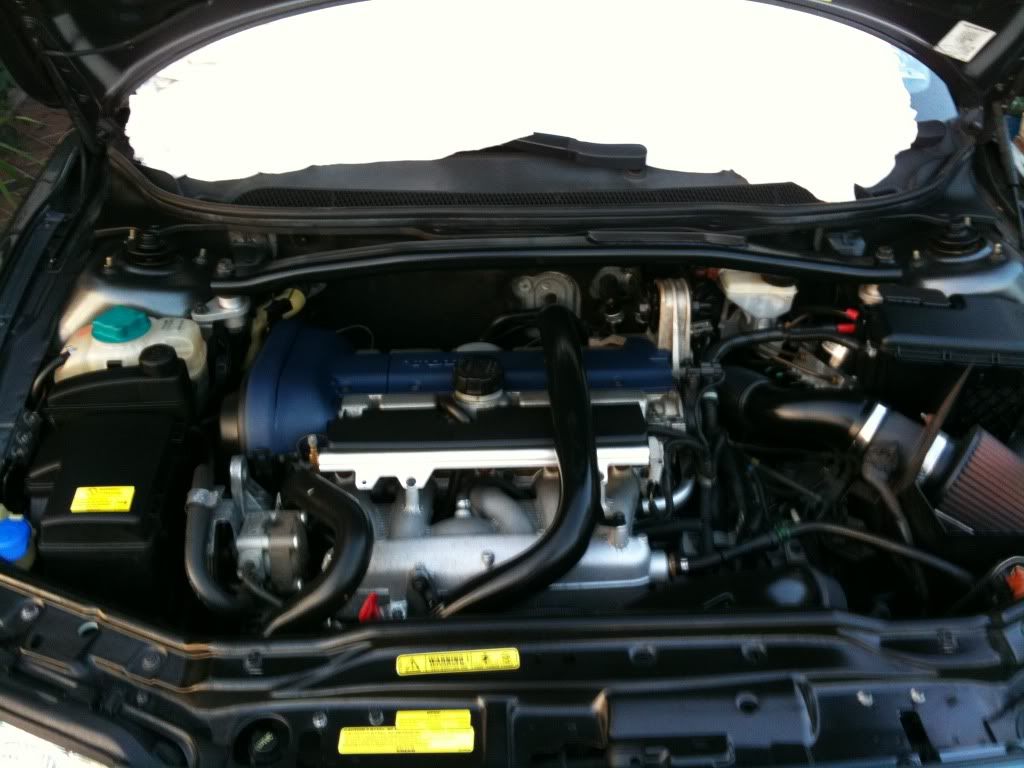Having spent too much time in my life hanging around car detailing guys and doing a decent amount myself (but never professionally), here are my thoghts:
1. Never use high pressure washers. Some pros do becasue it's fast, but you really neeed to know what you are doing.
2. Never clean on a running engine. Actually, many remove the ground connector to avoid any random electrical shorts.
3. Cover as many connectors as you see fit, for most cars you don't have to cover anything.
4. Spray degreaser (Simple green diluted is just fine) on a warm, not hot engine. Having the engine warm allows for easier removal of stubborn oil and grase deposits. The best way is to have the car cool off before cleaning since if you start it to warm up, you will have a hot exhaust etc before block is warmed up. If you are uncertain about this, leave it cool, many degreasers leave nasty stains if burned off.
5. Use brush to clean small areas.
6. Rinse using normal hose, pref on "soft" or "shower" setting. Be smart - don't aim directly at connectors, fuses, or alternator.
7. If you have access to air - use it to blow things dry. Same thing - be smart and do not aim right at connectors etc since you may actually force water into sensitive areas.
8. Reconnect ground, start engine and let it warm up to evaporate any remaining water.
9. Good advice above - certain cars with recessed spark plugs can be challenging. Audi and VW are famous for faulty ignition coils where the O-rings don't seal well and you get standing water in the recesses. Poff - 4, 6, or 8 new coils may be needed for every engine clean. If you can - always cover and/or blow dry.
10. Apply engine dressing of yuor choice. Looks pretty but not really neccessary.
10. When you are ready to join the real geeks - go to Autopia.
http://www.autopia.org/forum/guide-detailing/80226-engine-cleaning-detailing.html
I detailed professionally for a couple years so I'll offer my insight to clarify a bit here:
1.) You are partially right here. On certain cars I wouldn't do it. I'd never use the heat function on a pressure washer when cleaning an engine. As long as the major components (alternator, intakes, exposed connectors, battery terminals etc.) are covered properly, or you can find a way to spray away from them, you should be fine.
2.) I disagree here. I have seen more electrical/starting issues when people clean an engine using water when it's OFF than when the engine is running. I agree it shouldn't already be hot; I typically let the car cool down (hood open with a fan) for a while before cleaning the engine. Not completely, to avoid the hot exhaust before engine like you said, but I always start the car before I start cleaning. 2 reasons, if the engine is already running, and you hit something with the water that you shouldn't and the engine shuts off, you know exactly where to troubleshoot. And the second, because once you're done cleaning you can close the hood and leave the engine running, to allow the engine and exhaust heat to help dry off the components.
3.) Agree here, except on the volvos. You should most definitely cover anything that looks electrical and could be water damaged.
4.) Simple green is good. Greased lightning, P21S APC (more expensive) is also good. The best I have come across thus far is Sprayway 985 Citrus Crazy Clean. Originally designed to degrease industrial machinery, the stuff is just great for degreasing and cleaning engines. Ironically, since it's based on orange oils and no harsh chemicals, I also use it to clean interiors because it leaves a really nice orangey smell behind and is great for delicate leather (atacama or nordkap) and plastics/vinyls.
5.) Brush is a good idea in most cases. I'd recommend a rag more often if you can get your hand in there, and no stiff wire brushes.
6.) Agreed here, though a pressure washer on a low setting with a high angle end (meaning don't go for the 5*, it'll take the paint off your engine bay. Go for a 20* or 35* if possible) and no heat works best on stubborn stuff.
7.) Agreed here, not only in the engine bay but on the exterior too. Nothing worse than phantom drip lines from the side view mirrors or rub strips, or door handles on a freshly waxed car.
8.) Don't necessarily NEED to disconnect ground. As I said above, I'd prefer to clean the engine while running.
9.) as silly as it sounds, I'd pull the coil cover on our R cars, and lay a few pieces of electrical tape over a piece of paper towel, then replace the cover. That'd prevent that from happening. Or, clean that area just separately.
10.) Engine dressing is OK, the tire shine method works as well, but I personally think the greasy shiny engine bay looks like crapola. I'd rather have just the clean, fresh looking plastics. A thin layer of dressing won't add too much shine. Apply it, then let it sit for a few minutes, then buff with a microfiber. Works every time.
In closing, autopia is the ****. Not just for the forum, but because they sell the good ****. Also check out Rightlook.com and SparkleAuto.com for products.
















